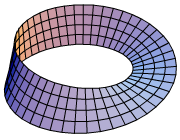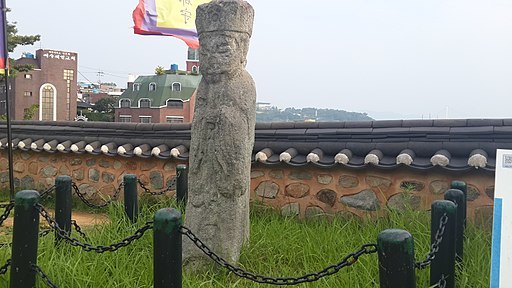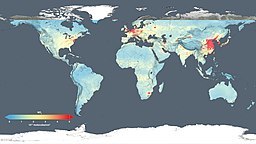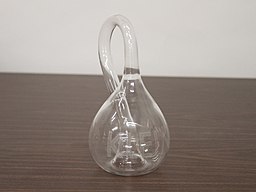The World's Literature in Europe discussion
Cho Se-hui. "The Dwarf"
date newest »
newest »
 newest »
newest »
 Story: "The Möbius Strip"
Story: "The Möbius Strip"A mathematics teacher tells a classroom of graduating seniors two stories, one about a pair of chimney cleaners and another about a two-sided paper becoming a single curved surface.
A basic Möbius strip of one half-twist, n=1

The text then diverges into a developing plot about Squatlegs and Humpback, the process by which a residential developer lowballs the worth of their village's dwellings while buying their deeds of possession, and to what end he comes.
The high school scene returns, and the students hear these parting words: "Imagine a solid where you can't divide inner and outer--a Möbius-type solid. The universe--infinite, endless--we can't seem to tell its inside from its outside. This simple Möbius strip conceals many truths. [...] Make absolutely sure, gentlemen, that you never compromise your knowledge for the sake of self-interest." -- Cho Se-hui
As to what those sayings symbolize here and later on might be a consideration to keep in mind while reading.
 Story: "Knifeblade"
Story: "Knifeblade"Entering midway to install a faucet at the outdoor spigot, the Dwarf hefts a shoulder bag in which he carries a handyman's toolkit. As he finishes the installation, a business competitor who digs water wells has been chasing him and finding him attacks. The woman Shin-hae, who hired the Dwarf, fends the assaulter off with a long filet knife.
In a prior scene, the reader learns about Shin-hae's extended family and neighborhood through a mother-daughter conversation and an intrusion by the neighbors' loud televisions. Unlike her female neighbors, Shin-yae demonstrates kindness and trust by hiring the Dwarf, whose own family suffers from his children's loss of jobs.

Photo of the writer Cho Se-hui by Yonhap News at http://www.korea.net/NewsFocus/Cultur...
 A great start to the Korea plan; one of my rare five star reviews:
A great start to the Korea plan; one of my rare five star reviews:Cho Se-hui, The Dwarf [1978, tr. 2015] 248 pages
A best-selling novel and virtually a classic of modern Korean literature, The Dwarf was originally published as twelve separate stories which were later combined into a novel. It concerns the period of Korean history under President Park Chung Hee, when the country was being transformed from a largely agricultural economy to the industrial, technological country it is now. The forced modernization of the country created extreme class differentiation and class struggles, similar to those in the West during the Industrial Revolution (the parallel is discussed in the novel) as well as those in Jamaica during the fifties and sixties, and Egypt and India at about the same time: I was reminded of Mahfouz's Midaq Alley and Mistry's A Fine Balance. The book is largely about labor struggles, but as in those two novels the advanced style keeps it from being a simplistic "worker's novel" in the sense of "socialist realism." (It's suggested in some reviews of the book that the style was partly to disguise the political criticism in stories written under the repression, but I can't really believe that it wouldn't have been quite apparent to any half-competent censor.)
The first and last stories feature a math teacher talking about Mobius strips and Klein bottles, which establish a sort of symbolic theme of the interior and exterior becoming one, and two disabled persons, Squatlegs and Hunchback. The second story introduces the character of a poor house wife Shin-ae, who hires a dwarf to fix her outdoor faucet so she can get water. We next meet Yun-ho, the adolescent son of a well-off lawyer who is trying to get into the University. This story also introduces the character of his tutor, Chi-sop, who plays a role later in the novel. Through Chi-sop, Yun-ho meets the Dwarf Kim Pul-i (of course a symbol for the "little people", but also developed realistically as a character) and his wife and three children, the Eldest Son Yong-su, the younger brother Yong-ho, and the sister Yong-hui. The incident which begins the plot of the novel is when the slum neighborhood in which the Dwarf lives (ironically named Felicity Precinct of Eden District) is torn down as part of an Urban Renewal Project. Of course, there is much corruption involved and the compensation which the residents receive is not enough to get the apartments they are supposedly entitled to. As a result, the family moves to Ungang, an industrial area of toxic pollution, where the Dwarf dies (unclear whether by accident or suicide, but the latter is strongly suggested) and his three children get jobs in the factories of the Ungang group. This forms the longest story in the novel, "The Dwarf Launches a Ball", which is frequently published separately. (The Wikipedia article on the novel appears to confuse the two.) While the novel shifts among all the characters (it is sometimes difficult to follow who is doing what) the main focus is on the conditions in Ungang and the struggle against management and the complicit company-union, and the story of Yun-ho gets lost. Near the end, one story is about the leader of the Ungang group and his family.
 I found this MA thesis on the Internet; I wouldn't agree that The Dwarf is surrealist -- it seems very realist in style -- but the discussion of the novel is very interesting.
I found this MA thesis on the Internet; I wouldn't agree that The Dwarf is surrealist -- it seems very realist in style -- but the discussion of the novel is very interesting.https://open.library.ubc.ca/media/dow...
 James wrote: one of my rare five star reviews
James wrote: one of my rare five star reviews So... you like the novel by Cho. Then, in case you want to read a few more modern S. Korean novels, Human Acts by Han Kang (recipient of 2016 Man Booker International Prize) would be worth giving a try. You will probably like it as well... given that you gave Cho's novel a five-star review.
(By the way, I'm moot. I changed my GR nick)
 James wrote: "...I wouldn't agree that The Dwarf is surrealist [...] but the discussion of the novel is very interesting. https://open.library.ubc.ca/cIRcle/co...
James wrote: "...I wouldn't agree that The Dwarf is surrealist [...] but the discussion of the novel is very interesting. https://open.library.ubc.ca/cIRcle/co... ..."
Chapter 2 of it is devoted to surrealism in the linked stories of The Dwarf. In my reading of that part, I gathered that the characteristic of surrealism blended the real and the dream. On the structure of reality, the characters experience the fantasy.
In the story, "Space Travel," the tutor and dreamer Chi-sŏp reads a book set 10,000 years in the future. Also, he tells his student Yun-ho that he speaks to beings from outer space when he visits the area around the Dwarf's house. While living, not too well, in a country on earth, he revels in how the 'Land of the Moon' is by contrast. Chi-sŏp's opposite is the rapscallion In-gyu, who exalts experience unfamiliar to Yung-ho and inconsistent with his father's assumptions about the tutoring class. A crisis ensues when Yun-ho confronts his inability to bridge the chasm between his feelings and the circumstances and unknowns surrounding him.
 未知生焉知死 wrote: "... Human Acts by Han Kang (recipient of 2016 Man Booker International Prize) would be worth giving a try..."
未知生焉知死 wrote: "... Human Acts by Han Kang (recipient of 2016 Man Booker International Prize) would be worth giving a try..."Moot, Human Acts is this June 2019.
 "A Little Ball Launched by a Dwarf"
"A Little Ball Launched by a Dwarf"Part 1 of this novella introduces the dwarf's family, their ethos about life, their ancestry in slavery, their occupations, and their current living conditions as well as those of their neighbors facing demolition of the neighborhood, a gray, 'dead land,' in which "[t]here is not a soul who knows how to shed tears for others" who worked, obeyed the law and prayed. The ailing dwarf sending off a paper airplane to the moon from the lightning rod of the factory sends a message implying that the man in the moon might be more receptive to his and his neighbors' situations.
The younger son who works in a print shop narrates Part 2. Challenging but relatively brief disappearances find an explanation in a landing flying saucer. In the plot, the dwarf's family and their neighbors get bamboozled. His sons plan to negotiate with factory management to improve working conditions in the worsening sweatshop, but they lose their jobs over it. The notice that occupants must demolish their dwellings leaves the neighborhood without information on how to effect the exchange of occupancy rights into a new apartment or condo works. Word-of-mouth in the neighborhood vies with the world apart of bureaucracy and outside buyers to sell their occupancy rights instead of moving into a new residence. The dwarf's family situation has roots at least five hundred years in the past through several generations of hereditary slavery in which nothing changed. In spite of material poverty, the father (dwarf) values reading and education and sees events as "a conflict between what's right and what's wrong."
The daughter Yŏng-hŭi narrates Part 3. Her demeanor remarkably differs from her mother's traditional guidance. Even so, the family waits for a long time when she disappears. Her motive for disappearing relates to leveling the playing field for her family. Her success at that and the situation surrounding her parents and siblings during her absence leave off with her hallucinatory dreaming.
Joseph Robert Voights's article "Spatial Metaphor in Cho Se-hui's The Dwarf" http://www.academia.edu/28137673/Spat... establishes that in Cho's novel neither violence nor materialism without idealism (ethics) produces change, whereas listening and making space for another do so.
 "On the Footbridge" narrates a memory by a middle-class female character Shin-ae. She appeared earlier when the handyman Dwarf replaced her low-pressure spigot with a faucet after which she intervened to save him from an aggressive competitor.
"On the Footbridge" narrates a memory by a middle-class female character Shin-ae. She appeared earlier when the handyman Dwarf replaced her low-pressure spigot with a faucet after which she intervened to save him from an aggressive competitor. In this chapter, she's at a footbridge in a park in the busy city, having visited her brother in the hospital. The location prompts her to recall memories about his college years and afterward with job and family. The story's plot questions the reason youths on the verge of adult responsibility give up on living their ideals. In this story, it's not being hypocritical, saying what one truly feels, and fighting against oneself not to surrender to the other side.
Her memory mixes perhaps three periods in his life and that of his closest friend. In college, the two with others at first protested against silencing dissent. In response, the university put final examinations on hold, a delay which dampened many students' enthusiasm for further protest. The next time frame occurs as adults with successful lives when her brother waits to meet his friend in the park near the Statue of Admiral Yi Sun-shin. The scene shifts again to the present in the hospital.
The dialogue between the friends suggests that idealism may be incompatible with a materially good life. One review says it thus:
"It’s a fight for a good education and a successful future, but it’s a struggle during which most will have to decide between their conscience and the chance of a happy future." https://tonysreadinglist.wordpress.co... .The proximity of the famous statue her brother observes from the park bench while awaiting his friend carries meaning, if irony, as the sixteenth-century historical figure symbolizes "uncompromising integrity," says Kallie Szczepanski in "Yi Sun Shin, Korea's Great Admiral" https://www.thoughtco.com/admiral-yi-... In addition to the admiral's commanding presence in the busy, dusty city of Seoul, there exists in Jinnamgwan, Yeosu, South Korea, a smaller, older commemorative statue left among the original seven the admiral himself 'stood' during his lifetime.

by Mar del Este
 In "Orbital Rotation," the family of Yun-ho moves out of the low-lying, sewer canal of Felicity district in which the Dwarf's family lived into a community in the beautiful, fragrant Pugak mountains. Next door lives pretty Kyŏng-ae, in mourning at her grandfather's recent death.
In "Orbital Rotation," the family of Yun-ho moves out of the low-lying, sewer canal of Felicity district in which the Dwarf's family lived into a community in the beautiful, fragrant Pugak mountains. Next door lives pretty Kyŏng-ae, in mourning at her grandfather's recent death. Observing Yun-ho's interest in the booklet "The Worker's Handbook," which describes civil rights laws applicable to conditions in the workplace, she invites him to a youth discussion about 'teenage workers.' There, most participants express sympathy for people in those situations which cancel lawful rights. Yun-ho, however, admonishes their incomprehension about those lives and the ineffectiveness of their feelings. Then he dramatizes a simulation between power and powerlessness. Shockingly, the story reveals that (view spoiler)
 In "City of Machines," the dwarf's three children work and live in a seaside industrial city called Ŭngang. The name presumably derives from the ownership of many factories by the large business Ŭngang Group, located in Seoul.
In "City of Machines," the dwarf's three children work and live in a seaside industrial city called Ŭngang. The name presumably derives from the ownership of many factories by the large business Ŭngang Group, located in Seoul. Wind usually moves the polluted air and wastewater out to sea and pollution inland. No one who is not affected cares to do anything about the miasma, and those who do care cannot accomplish change. Workers cannot beget better working and environmental conditions. Unions serve management, which considers workers as cash cows for profits, a prohibition prevents demonstrations, and threats characterize social control. By the end, reader and narrator (lawyer's son Yunho) observe the frustration of the dwarf's eldest son.
"Everything's one-sided. Nothing goes according to the law. All we do is lose. I've lost face with the people I work with. And the only thing I've given them is more trouble."Ensuing chapters probably reveal what happens after that to him. The only surreality may come in responses on the workers' survey. Many responders continue to believe in hard work, careful spending, and saving as the way to earn a comfortable life.
Karen Thornber in the anthology "Routledge Handbook of Environment and Society in Asia" (ed. Harris, Lang) chapter 4 lists fiction titles on the theme of environmental degradation in the Far East. In addition to Cho's The Dwarf set in 1970s Korea, the other stories include:
Jiang Rong. Wolf Totem;"Korea Journal" published Cho's story "City of Machines" in English translation in Vol. 30 No. 3 March 1990 pp. 68–74 at https://www.ekoreajournal.net/main/in... .
Ishimure Michiko. Sea of Suffering
and Pure Land: Our Minamata Disease;
Huang Chunming. Set Free (short story); and
Nguyễn Huy Thiệp. The Salt of the Jungle (short story).

"VIDEO (01:42): Using new, high-resolution global satellite maps of air quality indicators, NASA scientists tracked air pollution trends over the last decade in various regions and 195 cities around the globe. The United States, Europe and Japan have improved air quality thanks to emission control regulations, while China, India and the Middle East, with their fast-growing economies and expanding industry, have seen more air pollution. Credits: NASA." https://www.youtube.com/watch?v=aMnDo...
 The setting of "The Cost of Living for a Family of Ŭngang Laborers" happens soon after the Dwarf's death, so the family is in mourning. The daughter Yŏng-hŭi remembers a German town called Lilliput built for dwarves, an 'autonomous community' without factories and safe for her father. The middle son Yŏng-ho dreams his father rides in the hollow of a copper spoon. Not dreaming, the family sees its socioeconomic situation as on the bottom of the 'food chain' and their formerly robust Dwarf as now 'a half-handful of ash' flowing downstream further away from them.
The setting of "The Cost of Living for a Family of Ŭngang Laborers" happens soon after the Dwarf's death, so the family is in mourning. The daughter Yŏng-hŭi remembers a German town called Lilliput built for dwarves, an 'autonomous community' without factories and safe for her father. The middle son Yŏng-ho dreams his father rides in the hollow of a copper spoon. Not dreaming, the family sees its socioeconomic situation as on the bottom of the 'food chain' and their formerly robust Dwarf as now 'a half-handful of ash' flowing downstream further away from them. The oldest son Yŏng-su narrates this story in the industrial town Ŭngang, which represents a family move from their former neighborhood in the Felicity Precinct. Each child works in one of its factories, and the narrator describes those jobs and the human toll as a result. On the bright side, the whirring, movement, and process of technology fascinate Yŏng-su's attention. On the downside, the rushing pace and high-decibel racket ravage nerves and body. There also are abuses as when Yŏng-su complains that the compensation in his paycheck is not commensurate with policy regulations for overtime he experiences problems with his tools. With all the children working, the mother's itemized budget in the text demonstrates a shortfall in revenue.
 In "The Fault Lies with God as Well," Yŏng-su observes a conference of five laborers and five employers which exchanges thoughts in a play-like format of speaking roles. The employer-worker stances aren't new, but the author oddly intersperses into the factory dialogue speaking parts for Yŏng family members, who speak from events in the Dwarf's lifetime.
In "The Fault Lies with God as Well," Yŏng-su observes a conference of five laborers and five employers which exchanges thoughts in a play-like format of speaking roles. The employer-worker stances aren't new, but the author oddly intersperses into the factory dialogue speaking parts for Yŏng family members, who speak from events in the Dwarf's lifetime.
 "The Klein Bottle"
"The Klein Bottle" While Mother gathers and dries sea bark for fuel, she futilely advises the elder son Yŏng-su about doing his job as an assistant mechanic in the textile factory instead of taking informal classes about labor activism. The family though accepts his not contributing any earnings to running the household.
Memories of Father come to the fore as when the tutor Chi-sŏp approved by Father makes a visit and when Yŏng-su remembers Father's conversation about dying or joining a troupe of medicine peddlers. Chi-sŏp visits Ŭngang and the Dwarf's family. Since his last visit, he worked at various industrial jobs and acquired a reputation for successful labor agitation. He argues with Yŏng-su about the latter's zealousness.
"What's your reason for doing something that someone else would do if you didn't?"In another passage Mother describes her horrible dream about Yŏng-su's future.
The story's title "The Klein Bottle" enters the story through the character known as 'man of science.' The younger man applies its spatial significance to 'commonsense' situations:
"If you just follow the wall, you can get out. So in this world the notion of enclosure itself is an illusion."

Photo: Lenore Edman, Sunnyvale CA, Eggbot & Klein Bottle.
 Someone with an appreciation for math fiction like "The Möbius Strip" and "The Klein Bottle" might find reading at this URL: http://kasmana.people.cofc.edu/MATHFI... .
Someone with an appreciation for math fiction like "The Möbius Strip" and "The Klein Bottle" might find reading at this URL: http://kasmana.people.cofc.edu/MATHFI... .
 "The Spinyfish Entering My Net" may be the most captivating and passionate of this dozen, linked stories. Kyŏng-hun, the youngest son of Ŭngang Group's chairman who stands to inherit the conglomerate, narrates the spectacle. His mental narration pivots on the trial of the Dwarf's oldest son Yŏng-su. The latter stabbed the narrator's uncle with a knife meant for his father. While listening and watching the proceedings, his thoughts sort out the opposing sides of the tragedy, i.e., the factory workers and management. In his doing so, he vividly portrays each side as if the repercussion from the incident and the situation leading up to it raises his consciousness about the employee's perspective as well as the love absent in his family.
"The Spinyfish Entering My Net" may be the most captivating and passionate of this dozen, linked stories. Kyŏng-hun, the youngest son of Ŭngang Group's chairman who stands to inherit the conglomerate, narrates the spectacle. His mental narration pivots on the trial of the Dwarf's oldest son Yŏng-su. The latter stabbed the narrator's uncle with a knife meant for his father. While listening and watching the proceedings, his thoughts sort out the opposing sides of the tragedy, i.e., the factory workers and management. In his doing so, he vividly portrays each side as if the repercussion from the incident and the situation leading up to it raises his consciousness about the employee's perspective as well as the love absent in his family.
 "Epilogue" returns the linked stories to the beginning chapter: the departing math teacher who will teach ethics or go to a small planet in outer space, and his students whom he exhorts to study hard and succeed in college in spite of their dismal scores again on the math preparation exam. The characters Humpback and Squatlegs return after their violent exchange with the duplicitous real estate agent. It all echoes the theme of irresponsible industrial modernization and its consequences as evidenced in dirty river water with belly-up, deformed fish, rare fireflies and other natural life, and human affliction as a way of life. Worse, those conditions seem permanent.
"Epilogue" returns the linked stories to the beginning chapter: the departing math teacher who will teach ethics or go to a small planet in outer space, and his students whom he exhorts to study hard and succeed in college in spite of their dismal scores again on the math preparation exam. The characters Humpback and Squatlegs return after their violent exchange with the duplicitous real estate agent. It all echoes the theme of irresponsible industrial modernization and its consequences as evidenced in dirty river water with belly-up, deformed fish, rare fireflies and other natural life, and human affliction as a way of life. Worse, those conditions seem permanent. Like the tenacious teacher, the author doesn't completely despair. He acknowledges freedom and love which breathe life into the most dismal conditions -- "Whether we live on Earth or another planet, our spirit is always free" and "No matter what happens [...] I have to head for the little ones and their mom," Squatlegs says in the latter. Those seem the only escapes with the addition of scientific understanding. After "Epilogue," The "Afterword" chapter brings together those or more themes of the book.
Books mentioned in this topic
Wolf Totem (other topics)Human Acts (other topics)
Human Acts (other topics)
Authors mentioned in this topic
Karen Thornber (other topics)Huang Chunming (other topics)
Nguyễn Huy Thiệp (other topics)
Han Kang (other topics)



The dozen linked stories narrate the theme from several viewpoints of characters from different social classes in Seoul, South Korea. Each chapter first saw the light of day in a magazine; each can stand by itself.
The title names the main character, identified by his size as well as powerlessness as rapid modernization replaces the social fabric with dehumanization. The laboring family loses its shanty home with no place else to live, while the consequences of authoritarian, laissez-faire policies without empathy, of abuse, and violence portray a Dickensian account.
Among the published commentaries about this fictional work, a couple of them are:
https://en.wikipedia.org/wiki/The_Dwa...
and
http://www.dramasrok.com/2017/08/impo...